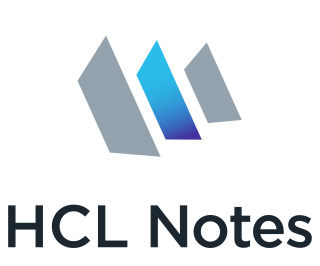
HCL Notes is a proprietary collaborative software platform for Unix (AIX), IBM i, Windows, Linux, and macOS, sold by HCLTech. The client application is called Notes while the server component is branded HCL Domino.

Db2 is a family of data management products, including database servers, developed by IBM. It initially supported the relational model, but was extended to support object–relational features and non-relational structures like JSON and XML. The brand name was originally styled as DB2 until 2017, when it changed to its present form.
IBM DevOps Code ClearCase (also known as IBM Rational ClearCase) is a family of computer software tools that supports software configuration management (SCM) of source code and other software development assets. It also supports design-data management of electronic design artifacts, thus enabling hardware and software co-development. ClearCase includes revision control and forms the basis for configuration management at large and medium-sized businesses, accommodating projects with hundreds or thousands of developers. It is developed by IBM.
A patch is data that is intended to be used to modify an existing software resource such as a program or a file, often to fix bugs and security vulnerabilities. A patch may be created to improve functionality, usability, or performance. A patch is typically provided by a vendor for updating the software that they provide. A patch may be created manually, but commonly it is created via a tool that compares two versions of the resource and generates data that can be used to transform one to the other.
HCL Sametime Premium is a client–server application and middleware platform that provides real-time, unified communications and collaboration for enterprises. Those capabilities include presence information, enterprise instant messaging, web conferencing, community collaboration, and telephony capabilities and integration. Currently it is developed and sold by HCL Software, a division of Indian company HCL Technologies, until 2019 by the Lotus Software division of IBM.

Windows NT 3.1 is the first major release of the Windows NT operating system developed by Microsoft, released on July 27, 1993.
WebSphere Application Server (WAS) is a software product that performs the role of a web application server. More specifically, it is a software framework and middleware that hosts Java-based web applications. It is the flagship product within IBM's WebSphere software suite. It was initially created by Donald F. Ferguson, who later became CTO of Software for Dell. The first version was launched in 1998. This project was an offshoot from IBM HTTP Server team starting with the Domino Go web server.
Microsoft Servers is a discontinued brand that encompasses Microsoft software products for server computers. This includes the Windows Server editions of the Microsoft Windows operating system, as well as products targeted at the wider business market. Microsoft has since replaced this brand with Microsoft Azure, Microsoft 365 and Windows 365.
A dedicated hosting service, dedicated server, or managed hosting service is a type of Internet hosting in which the client leases an entire server not shared with anyone else. This is more flexible than shared hosting, as organizations have full control over the server(s), including choice of operating system, hardware, etc.
IBM Storage Protect is a data protection platform that gives enterprises a single point of control and administration for backup and recovery. It is the flagship product in the IBM Spectrum Protect family.
Microsoft Forefront is a discontinued family of line-of-business security software by Microsoft Corporation. Microsoft Forefront products are designed to help protect computer networks, network servers and individual devices. As of 2015, the only actively developed Forefront product is Forefront Identity Manager.
This is a comparison of notable free and open-source configuration management software, suitable for tasks like server configuration, orchestration and infrastructure as code typically performed by a system administrator.
Aldon is a business unit of Rocket Software. It develops, manufactures, licenses and supports software change management products for the enterprise application lifecycle management (ALM) and software change management (SCM) markets.
AnthillPro is a software tool originally developed and released as one of the first continuous integration servers. AnthillPro automates the process of building code into software projects and testing it to verify that project quality has been maintained. Software developers are able to identify bugs and errors earlier by using AnthillPro to track, collate, and test changes in real time to a collectively maintained body of computer code.
Radia Client Automation software is an end-user device lifecycle management tool for automating routine client-management tasks such as operating system deployments and upgrades, patch management, application software deployment, application use monitoring, security, compliance, and remote system management.

IBM MaaS360 is a SaaS Unified Endpoint Management (UEM) solution offered by IBM that manages and protects any existing endpoint including laptops, desktops, mobile devices and apps, wearables, IoT and purpose built devices and allow protected, low risk access to company resources. IBM Security MaaS360 with Watson integrates with current security platforms owned by different companies. It’s AI powered analytics removes friction by reducing actions required from the device user.

Atera Networks is an IT management software that integrates functionalities such as remote monitoring and management (RMM), patch management, and operational automation alongside operational aspects like help desk, and ticketing systems.
Patch management is concerned with the identification, acquisition, distribution, and installation of patches to systems. Proper patch management can be a net productivity boost for the organization. Patches can be used to defend against and eliminate potential vulnerabilities of a system, so that no threats may exploit them. Problems that can arise during patch management, including buggy patches that either fail to fix their problem or introduce new issues. Patch management tools can help orchestrate all of the procedures involved in patch management.




